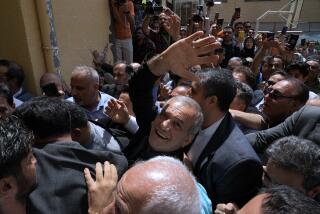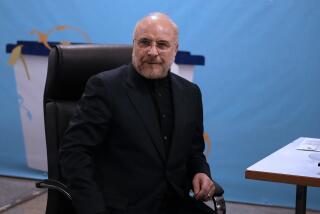Media : Iran’s Revolution Finally Learns to Laugh at Itself : * Tehran’s biggest-selling magazine takes jabs at Parliament members and even mullahs.
- Share via
TEHRAN — And now, the country that brought the wrath of radical Islam to the world brings forth a weekly collection of chuckles from someone called the Flower Man.
Call it Iranian glasnost, or merely a pleasant relief valve in a time of economic troubles. Whatever the reason, the Islamic revolution has--almost--learned to laugh at itself.
Tehran’s Golagha (Flower Man) satirical magazine has quickly become the largest-selling periodical in the country, featuring a weekly dose of humorous jabs at ministers, Parliament members, foreign politicians and even an occasional mullah--most often seen through the eyes of a mustachioed, Iranian version of Alfred E. Newman.
Nor is Golagha the only publication making waves these days in a country that has widely been viewed as inhospitable to dissent. Tehran’s newsstands during the recent parliamentary election campaign were full of daily newspapers robustly debating the campaign, often roasting the incumbents, one another and the government of President Hashemi Rafsanjani.
Indeed, no one, it seems, is safe from the journalistic pen in Iran these days--with the exception of its most revered religious leaders, whose names have seldom been linked with laughs anyway.
Earlier this month, a caricature in a little-known magazine of the late Ayatollah Ruhollah Khomeini dressed as a soccer player led to the prompt demolition of the publication’s offices by religious zealots and the arrest of its editors. Islam itself, and the principles of the revolution, still aren’t considered proper punch lines.
Within those constraints, Golagha, with its mixture of satirical columns and full-color cartoons, can be strikingly pointed. One recent illustration, for example, showed a man--representing Iran--lying face down on an examining table with his buttocks spread apart, about to receive an enema labeled “foreign loans.”
Another mocked Foreign Minister Ali Akbar Velayati’s recent travels to obscure African countries with which Iran, on the lookout for new allies, has been seeking relations. He was shown in safari wear, poring over a map with a magnifying glass.
Palestine Liberation Organization Chairman Yasser Arafat is regularly depicted as in Uncle Sam’s pocket. So are the Arab sheiks on the other side of the Persian Gulf. And with Iran’s present wave of crippling inflation, the economy minister and Central Bank governor have been the targets of pitiless mirth. They are usually shown as helpless or incompetent to control the economic monster that has been unleashed on the luckless Iranians.
“After the revolution and especially with the situation of the war with Iraq, satire and humor was within the people, but it had no reflection on the newsstands. The Iranian people are not upset by nature. And even if there are very hard economic conditions, they are the people of a smile,” said Golagha’s 50-year-old editor and publisher, Kiyoumars Saberi, who launched the publication about 18 months ago.
Since then, Golagha has gone from a monthly to a weekly and has attained a circulation of 131,000, compared with about 10,000 to 30,000 for most Iranian weeklies. It’s estimated that about a million people read each issue.
“People need something like this. We are filling their spare time, and at the same time we are portraying the real facts people are looking for,” Saberi said. “People want to cry out their difficulties through humor, and they are looking for a safe channel.”
Rafsanjani’s face is one of the few that never appears in the pages of Golagha. That’s because of Saberi’s strict policy of not visually ridiculing the dress of clerics, which also lets religious leader Ayatollah Ali Khamenei and lots of others off the hook.
(On the other hand, Rafsanjani’s secular vice president, Hassan Habibi, is widely understood by readers to be the prime minister’s visual stand-in, and his image appears more frequently in the magazine than anyone else’s. In one recent cartoon, for example, Habibi is shown hanging on for dear life to a rising graph charting inflation in the country.)
While avoiding clerical caricatures, Golagha’s columns take frequent verbal swings at the mullahs, which has brought Saberi both a public denunciation on the floor of the Parliament and several threatening phone calls.
For example, he has taken on the Ayatollah Sadegh Khalkhali, the so-called “hanging judge” notorious for having personally hanged a man who served as one of the late shah’s last prime ministers.
He also satirized hard-line Parliament Speaker Mehdi Karrubi, another of the mullahs, who had recently married. “I was writing about his wife, and in my column some people were asking him, ‘Are you satisfied?’ ” Saberi relates. “He’s answering, ‘Yes, but if it were four wives it would be much more satisfactory.’ ”
As Saberi recalls, that’s when the threatening phone calls started. “ ‘Why did you make a joke of a clergyman?’ ” people wanted to know. “I told them that according to our belief, we only committed not to depict them as clergymen. We never said we wouldn’t talk about them.
“There are some people who are saying that publishing Golagha is a sin, and those who are reading Golagha are also committing a sin,” the editor smiles. “Journalism in this situation is always an adventure.”
The Khomeini caricature that closed down Farad magazine this month showed the late imam dressed as a soccer player at a game between Iran’s two main national teams, Independence and Victory. One of his arms is darkened to the elbow.
Few people profess to understand what the cartoon is about. Some have suggested that it depicts the religious leader as up to his elbow in blood. But most say they were offended simply by the depiction of the dead imam as a character in a cartoon, no matter what it purported to say.
Protesters who dragged the magazine’s furniture into the streets screamed: “The American publisher must be punished! The follower of Salman Rushdie must be punished! The last will of Imam Khomeini must be complied with.” A student spokesman said the building housing the magazine offices is “one of irreligion” and “must be blown to dust.”
The daily newspaper of those Iranian hard-liners most opposed to Rafsanjani, Salaam, has a critical bite of its own: It sneers both at the government and, occasionally, at religious conservatives it accuses of threatening cultural and intellectual freedom. The combination has made it Tehran’s best-read newspaper.
“At this point, the only source for the viewpoint of the rivals (of the government) is Salaam newspaper. All the mass communications are still in the hands of the government,” said Mohammed Musavi Khoienha, Salaam’s editor and a key political strategist for the hard-liners opposed to the prime minister.
Issues of press freedom raised by attacks such as the one on Farad magazine give food for thought to both Salaam and Golagha.
Though a mouthpiece for the hard-liners, Salaam wrote:
“The enemies of freedom are two groups, seemingly opposing, yet definitely co-plotters. One group are the despots (self-willed) and the intellectual and cultural dwarfs who are after limiting and threatening liberty--even its legitimate and legal kind--in various ways. They are different from those who defend their sanctities with their lives. They are the sworn enemies of freedom. They are fed by the other group, the group that takes freedom to mean chaos, laxity, lack of dedication, and even immorality, and acts accordingly, thus preparing suitable pabulum for the first group. Both groups complement each other to eradicate freedom in society.”
And Golagha Editor Saberi, while expressing regret over the sacking of Farad’s offices, defended closure of the magazine.
“As a journalist, of course, I didn’t like that while a government is ruling in a country that people take the law into their own hands,” he said. “But on the other hand, no one can stand an insult to the people’s beliefs. In our culture, an insult to a high clergyman is very saddening. I know some people who don’t like the regime at all, but they did not like Khomeini depicted like that. As an intellectual who has been a professor and a journalist, and someone who makes his living from political caricatures, God knows I was very offended by seeing that picture.
“Maybe you won’t be offended,” he told a Western journalist. “But that gets back to the difference between you and me.”
More to Read
Sign up for Essential California
The most important California stories and recommendations in your inbox every morning.
You may occasionally receive promotional content from the Los Angeles Times.













